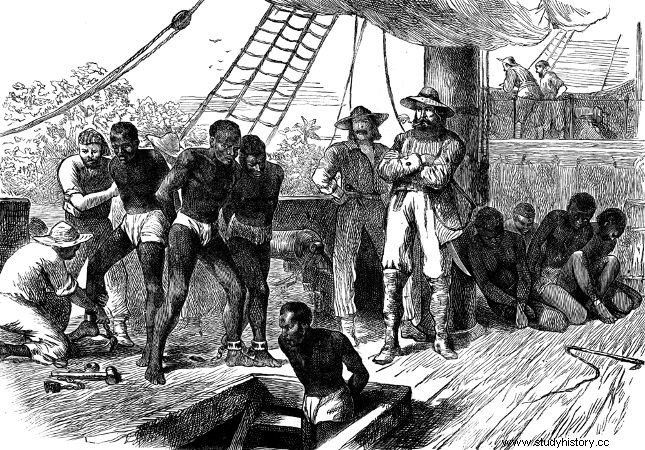
During the transition period from the pre-colonial to During the phases of the hereditary captaincies and the General Government, an important change took place in the labor relations of colonial Brazil:the use of slave labor was imposed. . The use of slave labor, at first, began with the exploitation of indigenous people, however, progressively, the use of Africans began.
Enslavement of the Indian
During the initial phase of Brazilian colonization, slavery was concentrated on indigenous labor. The enslavement of the indigenous occurred, mainly, in the extraction of pau-brasil. From the moment when the production of sugar, from the cultivation of sugar cane, became the main economic product of the colony, the transition to the use of African slave labor took place.
Historians cite some factors to explain the transition from indigenous to African use:mortality and flight of indigenous people and commercial imposition of the metropolis by the slave trade. Other reasons, such as the native's lack of adaptation to regular work, are currently disputed by historians.
Firstly, contact between indigenous peoples and Europeans led to a demographic reduction gigantic because of diseases such as smallpox and influenza, which decimated native populations. This was due to the natives' lack of biological defense against these diseases. The historian Boris Fausto indicates that, in 1562 and 1563, for example, epidemic outbreaks were responsible for the death of about 60 thousand indigenous people 1 .
Furthermore, it is considered that the demographic reduction of the indigenous population took place as a result of the wars fought against the Portuguese. Finally, many indigenous people fled to the interior of Brazilian territory to avoid contact with the Portuguese. Other issues raised by traditional studies, such as indigenous resistance to continuous and sedentary work, are being criticized by current studies.
Allied to this issue, historians suggest that, in addition to the demographic reduction of the indigenous population, the demand of the metropolis for the imposition of the slave trade was fundamental for the African slave labor to be disseminated in Brazil. This was because the slave trade was an extremely profitable activity for the metropolis.
African enslavement
African enslavement in Brazil began to receive incentives from the Crown after 1570 and, thus, according to historian Thomas E. Skidmore, from 1580 onwards, at least two thousand arrived in the Brazilian northeast. African slaves per year 2 . Slaves were brought to Brazil in vessels known as slave ships and in extremely precarious conditions. It was common for half of the captives brought in to die during the voyage as a result of these poor conditions.
These slaves originated from different regions of Africa, but historians suggest that, for the most part, they belonged to the Sudanese ethnic group. and the Bantos . In this regard, historian Boris Fausto states that:
In the 16th century, Guinea (Bissau and Cacheu) and Ivory Coast, that is, four ports along the coast of Dahomey, provided the largest number of slaves. From the 17th century onwards, the southernmost regions of the African coast – Congo and Angola – became the most important export centers, from the ports of Luanda, Benguela and Cabinda. Angolans were brought in greater numbers in the 18th century, corresponding, apparently, to 70% of the mass of slaves brought to Brazil in that century 3 .
Historians estimate that, throughout the history of African slavery in colonial Brazil, some four million Africans were brought . Slaves were used in the most diverse types of work, with greater emphasis on their use in sugar mills and in mining centers from the 18th century onwards.
The slavery regime in Brazil imposed on Africans (and indigenous people as well) a exhaustive and inhumane work regime . In addition, slaves were kept in precarious conditions, often poorly fed and victims of the most varied types of violence. This motivated foci of resistance among the slaves through sabotage and, mainly, escape.
The enslavement of Africans profoundly shaped Brazilian society. Culturally, the African presence influenced Brazilian culture in several aspects:music, cuisine, language, etc. In addition, it imposed a strong racial prejudice, which still reverberates in the 21st century and which needs measures to attenuate the existing social contrasts.
______________________
1
FAUST, Boris. History of Brazil. São Paulo:EDUSP, 2013, p. 46.
2
SKIDMORE, Thomas E. A History of Brazil, Rio de Janeiro:Peace and Land, 1998, p. 33.
3
FAUST, Boris. History of Brazil. São Paulo:EDUSP, 2013, p. 47.
by Daniel Neves
Graduate in History
Take the opportunity to check out our video lesson on the subject:
